One of the most successful airplane designs of all time is the Quicksilver. Van’s Aircraft of RV fame has delivered more kits, yet with 10,869 RVs presently flying, Quicksilver still remains far ahead with more than 15,000 flying. Naturally, such market success spawned other builders.
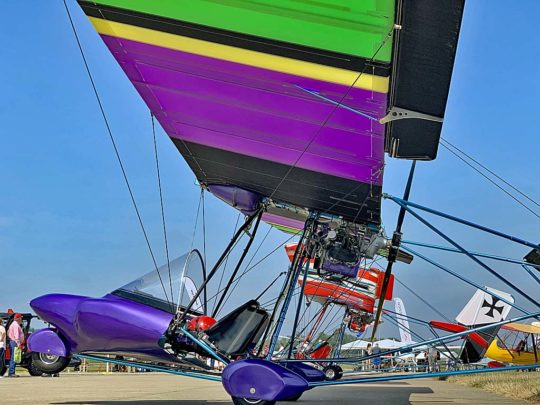 Those who attempted to copy and duplicate Quicksilvers have mostly faded away but some enterprises (see at bottom) built a business out of supplying parts and components that Quicksilver itself never offered.
Those who attempted to copy and duplicate Quicksilvers have mostly faded away but some enterprises (see at bottom) built a business out of supplying parts and components that Quicksilver itself never offered.
One of the most successful of these is Tri-State Kite Sales, based in Mt. Vernon, Indiana — and no, not Mt. Vernon, Illinois where the Midwest LSA Expo is held every September.
Andy Alldredge started his Falcon project 18 years ago when he was a lad of 20. The airplane looked good enough that I thought it was something new but, nope. This is a well flown aircraft that has been well maintained.
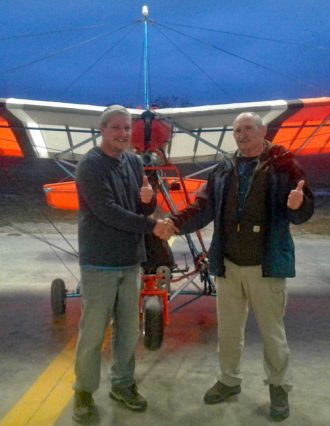
Andy Alldredge (L) poses with Tri-State Kite Sales founder, Mark Smith (R). Mark died in July 2017.
Let’s be fair. Andy has not exclusively labored on Falcon for 18 years. He said, “It was about a five year project, but I worked on it when I had spare time.” Based on my several inquiries since learning more about Tri-State Kite Sales* I have discovered this Indiana company has a very loyal following (mostly from their region) and they have an active, functioning enterprise.
At this point, I want to give credit to the founder of this business. Mark Smith was the man behind Tri-State and he started out making various components for Quicksilver aircraft that the then-California company chose not to pursue.
Quicksilver maintained their business focus on fabricating kits. They were amazingly successful at selling their line. Not only did they ship more than 15,000 kits over many years but in 1982 and 1983, they often claimed deliveries of more than 200 units per month!
Regretfully, Mark Smith died in July of 2017 but his longtime friend, Andy, kept the business going strong. Mark’s nephew Tom Smith also works with the business, handling most of the fiberglass work. The enterprise was and still feels like a family operation.
More on CP Falcon 503
“I wanted to thoroughly test it,” Andy said. Yeah, I guess! Eighteen years is a long development cycle but it was not originally intended for market. Yet, this once-personal project took on a life of its own.
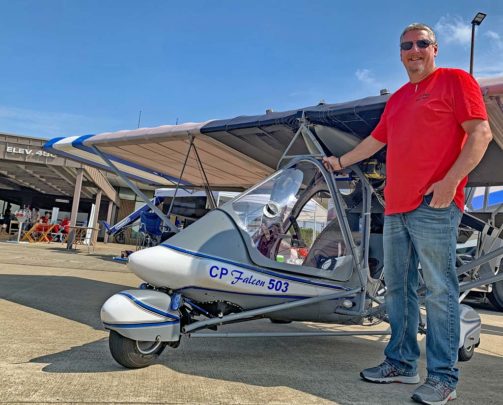
Falcon has a lot of components so it will be more expensive. “Yes,” Andy agreed, “it will be a little higher priced aircraft — it takes a lot of time to assemble — but it will fly like a Quicksilver, so those pilots who want to fly faster now have a choice.”
A Quicksilver-type design like the standard “Smithsilvers” that Tri-State makes from scratch typically cruise 40-60 mph where Falcon is as much as 50% faster.
“Yes, this will be a little higher-priced aircraft,” Andy observed, “and it must be built as an Experimental Amateur Built.” Let’s put it in perspective, noting that all prices mentioned below are subject to change.
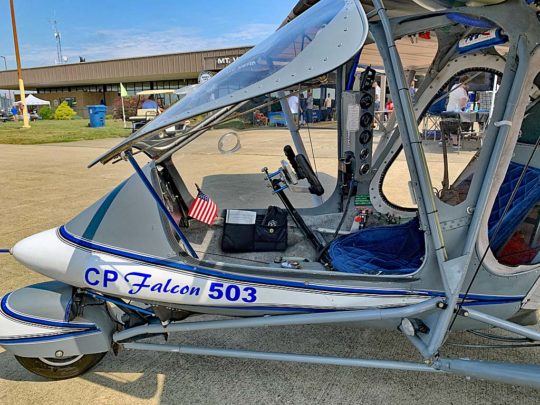
“I created Falcon to be a comfort cruiser for cross country flying,” Andy related. Falcon and the other Smithsilvers may look a lot like a Quicksilver but they are fully Tri-State creations after many years of operation.
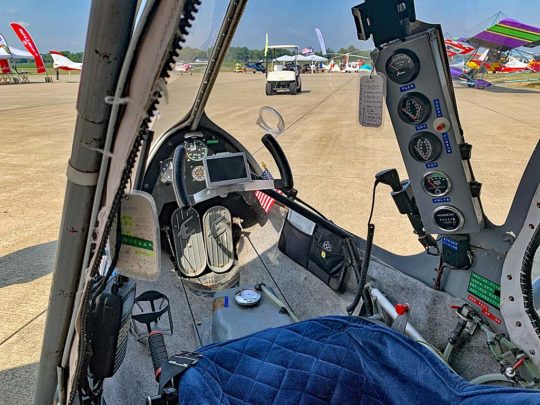
Of all these, Falcon may be the most advanced and sophisticated. It may look like a simple Quicksilver or a Tri-State Smithsilver but Falcon is a step beyond on many ways, for example, creature comforts.
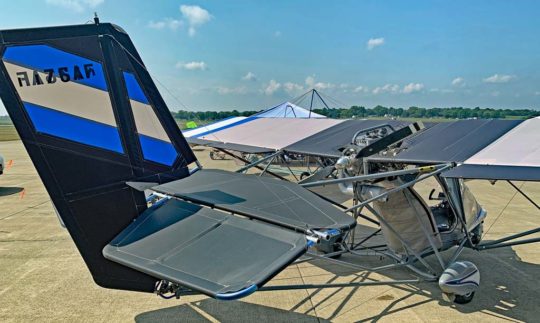
Cross country flying is one of the stated purposes. How fast can Falcon fly?
“I can hit 93 miles an hour,” exclaimed Andy, “and cruise is a solid 80 mph.” For those unfamiliar with a standard Quicksilver or Smithsilver, that’s a substantial increase, more than 20 miles an hour faster on average.
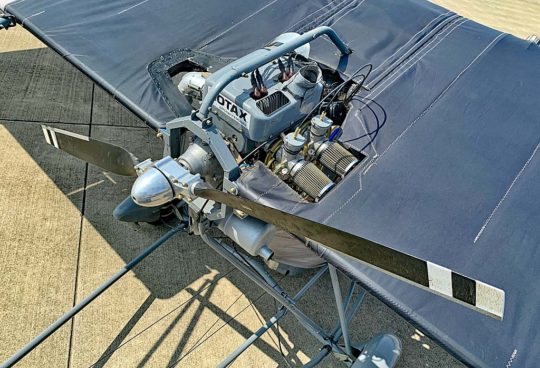
“Falcon’s standard instrument panel has all your flight information,” explained Andy, “while all the engine instrumentation is housed on the right vertical support strut. Above your head are all the electric switches for electric flaps, ignition switches and lighting controls.”
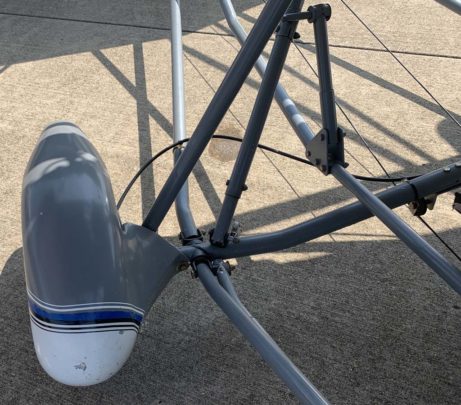
Falcon has a door that props open but when I looked at, I thought entry looked rather challenging. What I missed were the steps Andy took in designing a yoke that neatly folds out of the way. When so retracted, entering Falcon looks easy.
Once in place you pull the yoke back toward you and it latches securely into position. With details like this, no wonder Any spent years getting Falcon right on paper and three more to get the pieces and parts in the right place.
Falcon’s cabin even has a hat rack …or in this case, a headset rack as that’s what Andy puts in this location.
Want More Info?
At this time, Tri-State is making a much-needed update to their website.

Until the new website is finished, visit Tri-State’s “Hangar Talk” Facebook page. If you want more or are ready to act, use these contacts:
In this video, I interview Andy Alldredge about his Falcon at Midwest LSA Expo 2020.
* Tri-State Kite Sales is a name dating to the earliest days of Quicksilver, when the company that birthed this design was called Eipper-Formance (one of the original partners was named Dick Eipper). In those formative days of the mid-1970s, hang gliders were often generically called “kites.” Since the very first Quicksilver was an unpowered glider, early buyers casually called them kites as well. The name stuck even if it does not mean much these days.
Another large and very successful supplier of component parts and accessories for Quicksilver airplanes is Air-Tech, Inc., run by Gene “Bever” Borne and his son, Ken. They’re still at it but the Louisiana business now owns the entire Quicksilver line (excluding GT500) and continues to supply new kits, fully-built 103s, Special Light-Sport Aircraft models, and lots of parts and accessories needed by Quicksilver owners.


Tri-State kites is crazy with prices like that!!
Not everyone agrees with you but you are certainly entitled to your opinion.
Dan: Now, you’ve got to realize ultralights were designed originally for the normal working persons — not the well-to-do people. That is why they became so popular in the first place, because most people could be able to swing around $5,000 for a unit. Yes this was in the ’80s, ’90s or so but $70,000 for an ultralight that is about the same as a Sport 2s …come on!
I did a cost increase due to inflation years ago at an annual 5% inflation rate on a single-set Sprint. I started with the [then-] current price of $5,995, which was the going rate for new in 1987, [and calculated inflation for] the year 2007. The plane would have cost a total of $9,740 in 2007.
Now I don’t care even if you have inflation rate of 15% it won’t be 70,000. I’m sorry. It is not that Tri-State started with a blank drawing board, had to do all drafting, layups, build the unit, do all testing as with an original design. They started with a prototype per say. This cost (I believe ) is way out reach for the everyday working fellow! Even the Quicksilver GT-500 right before the factory went out of business was only around $40,000. That aircraft was a mountain against a molehill from the open-cockpit Quicks, so please don’t say people think it may be worth that price. I am sure there may be a few ill-informed people that may think so but I don’t think most will agree.
And just a bit of my background so you and your readers don’t think I am some quack talking. I was a certified Quicksilver dealer for over 20 years or more, sold many aircraft (all their line), come with over 45 years in the automotive repair industry, and also ran my own automotive repair shop for more than 14 years. Also, in the previous years I was a head tech for a Dodge dealership so I believe I may have some knowledge in these matters… not to mention I am still involved in both industries, albeit at a more limited bases. My 3 cents!
Your points are valid regarding inflation and the original cost of a Quicksilver single seater from the mid-1980s. However, it is is apples and oranges when comparing Falcon to a basic Quicksilver (or other models of Smithsilver, which cost far less). It is closer to compare Falcon to GT400 or GT500 but even that is not fair.
Whatever you think of Tri-State’s price for Falcon, please consider their other models, all of which are priced lower than Falcon, which is their top offering.
Your experience does indeed sound extensive and I am not dismissing your message. I only ask you to examine the company’s offerings more closely.
Tail winds!
Rotax 503 are out of production?
Yes, for a long time but many used ones are available, often with low hours on them.
We are fortunate to have Tri-State among the businesses keeping the Quicksilver[-type] design alive and vibrant. The new models are just icing on the cake! Huge thumbs up to Tri-State.
Thank you Dan for your continued coverage of ultralights and “light” light sport airplanes!
I first started doing business with Mark Smith around 1994 when I became a BFI. When I ordered my first part, I asked how I was to pay for it? Mark said he would send the part and the I could send him check. What a novel way to do business in today’s world. Fast forward to 2019 and I ordered parts from Andy. Since I had been an old-time customer, the same policy was still in effect. Thanks for great service from a very satisfied customer.
Ed Stephens, Arkansas
You are off base on Air-Tech Quicksilver line ownership in that Bever does not hold the rights to the GT500. Talk to him and he will confirm Mexico has the 500 rights to manufacture.
As for your description of Andy’s tutelage under Mark, a more apt description might be Andy was his young apprentice who started hanging out at Mark’s when he 10 years old. His first Quicksilver was an MX he had to assemble when he wanted to fly as he didn’t have a place to keep it on his family farm. Also your description on Tri-Kite following is far from the mark with customers as far away as South Africa and Canada. I know cause I met them at the Mark’s annual June get together.
Regarding Quicksilver and Air-Tech, I am happy to be corrected so readers have the best information. I’ve since corrected my article. • Regarding Tri-State, it probably would’ve been more accurate to say Tri-State originally built their business on a regional following (after all, Mark Smith did choose the name “tri-state”), but I am happy to hear of customers from very distant locations using Tri-State’s services. My hope is to expand their reach even further so thanks for your contribution, Bob, on both points.